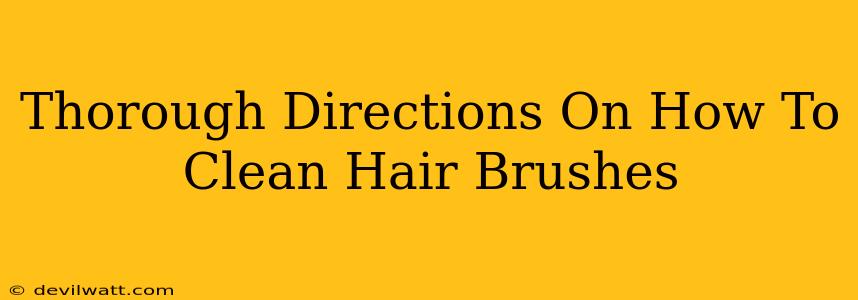Let's face it: hairbrushes are germ magnets. They collect hair, dust, product buildup, and let's not forget the occasional stray crumb. A clean hairbrush isn't just about aesthetics; it's crucial for maintaining healthy hair and scalp. This guide provides thorough directions on how to clean your hair brushes, no matter the type.
Why Cleaning Your Hairbrushes Matters
Before we dive into the how, let's talk about the why. Regular cleaning prevents:
- Bacterial buildup: A breeding ground for bacteria and fungi can lead to scalp irritation, dandruff, and even acne.
- Product residue: Leftover hair products can weigh down your hair, making it look dull and lifeless.
- Tangled hair: Accumulated hair makes brushing painful and ineffective.
- Reduced brush lifespan: Cleaning extends the life of your favorite brushes.
Choosing Your Cleaning Method: The Right Tool for the Job
The best way to clean your hairbrush depends on its type:
Paddle Brushes & Large Round Brushes:
These are typically easier to clean. We recommend the wide-tooth comb method:
- Remove Loose Hair: Use a wide-tooth comb to remove as much hair as possible. Work systematically, combing from the base of the bristles.
- Soapy Water Soak: Fill a bowl or sink with warm water and a few drops of mild dish soap (avoid harsh chemicals). Submerge the brush, bristles down, and let it soak for 15-20 minutes.
- Gentle Scrubbing: Gently scrub the bristles and the brush base with your fingers or an old toothbrush. Pay close attention to the areas where hair tends to accumulate.
- Rinse Thoroughly: Rinse the brush under running water until all the soap is gone.
- Air Dry: Lay the brush flat on a clean towel to air dry completely. Avoid placing it upright as this can cause water to seep into the handle.
Smaller Round Brushes (with natural bristles):
Natural bristles require a gentler touch.
- Initial Hair Removal: Use tweezers or a small comb to carefully remove any large clumps of hair.
- Gentle Shampoo Wash: Use a mild shampoo and lukewarm water. Gently massage the bristles and the brush head.
- Rinse and Dry: Rinse thoroughly and allow to air dry completely.
Detangling Brushes (with flexible bristles):
These brushes often have more intricate designs, making cleaning a bit more challenging.
- Comb Out Excess Hair: Use a small comb to remove excess hair between the bristles.
- Deep Clean with Soap: Use a small amount of dish soap and an old toothbrush to carefully clean the bristles and the base.
- Rinse and Air Dry: Rinse with warm water and lay flat to air dry.
Advanced Cleaning Techniques for Stubborn Buildup
For really stubborn product buildup or if your brushes are seriously grimy:
- Baking Soda Paste: Make a paste of baking soda and water. Gently apply it to the bristles, scrubbing with an old toothbrush. Rinse thoroughly.
- Vinegar Soak: Soak your brushes (excluding those with natural bristles) in a solution of equal parts water and white vinegar. This helps cut through grease and grime.
Maintaining Clean Brushes: Prevention is Key
Regular cleaning prevents the buildup of hair and product residue, making the cleaning process much easier. Aim to clean your brushes:
- Weekly: for daily use
- Bi-weekly: for less frequent use
Following these thorough directions will ensure your hairbrushes remain clean, extending their lifespan and contributing to healthier, happier hair. Remember to be patient and gentle, especially with brushes containing natural bristles. Happy brushing!

